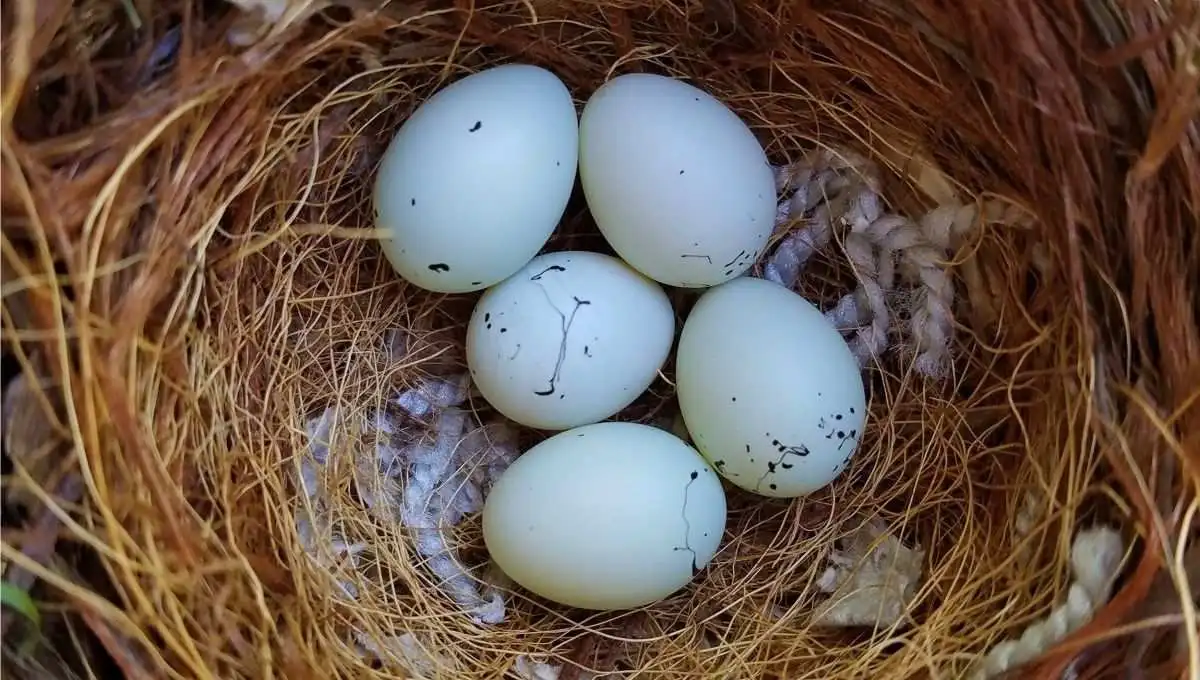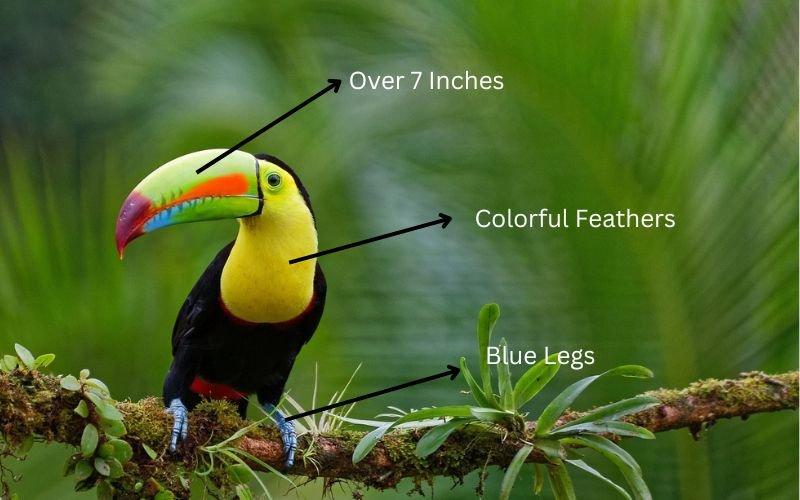
Toucans are very colorful as well as very beautiful birds in the world. They are especially known for their large, and orange color bright beaks.
They usually live in the tropical forests of Southern Mexico, Central and South America to northern Argentina. Toucans are very popular for their unique calls and stunning appearance.
In this article, I will explore toucan eggs, including, how many eggs they lay, how they look, the place where they lay eggs, and how they hatch. So, let’s learn about toucan eggs very deeply.
Toucan Eggs
In this section, I will explain to you how toucan eggs look, how long it takes to hatch, and how many eggs toucans lay. So let’s dive into these details:
#What do toucan eggs look like?
Have you ever seen a toucan egg or heard about their eggs? No, don’t worry, here are the easy details for you. Toucan eggs are very small and white.
Their eggs are oval-shaped and look like chicken eggs. The Toucan egg’s size is only 1.5 inches long.
# How long does it take for the eggs to hatch?
You already know about toucan eggs’ size, look, shape, and other details. Now, do you want to know how long does it take for the eggs to hatch?
Here is the hatching time: Toucan hatch their eggs usually after 15 to 20 days.
# How many eggs do toucans lay?
Other birds lay many eggs at a single time but Toucan can lay 2-5 eggs in a single clutch just like chicken.
Small Overview of Toucan:

Toucans are very colorful birds with very large, colorful beaks. They have black, white, yellow, and blue bright feathers on their body. These medium-sized birds can grow up to 18 to 24 inches long including their beaks.
Toucans are non-migratory social birds. They are often seen in small flocks. Their large beaks help them from different predators and eat food.
There are over 40 types of toucan species in the world. Most of them are vulnerable and endangered. Here is the full table:
| Species Name | IUCN Red List Status | Size (inches) |
|---|---|---|
| Yellow-browed Toucanet | Endangered | 13-15 |
| Yellow-eared Toucanet | Vulnerable | 14-16 |
| Chestnut-mandibled Toucan | Near Threatened | 19-24 |
| Swainson’s Toucan | Near Threatened | 20-23 |
| Choco Toucan | Near Threatened | 19-21 |
| Plate-billed Mountain Toucan | Near Threatened | 16-18 |
| Black-billed Mountain-Toucan | Near Threatened | 16-18 |
| Chestnut-mandible Toucan | Near Threatened | 15-17 |
| Spot-billed Toucanet | Near Threatened | 12-14 |
| Tawny-tufted Toucanet | Near Threatened | 10-12 |
| Keel-billed Toucan | Least Concern | 17-22 |
| Toco Toucan | Least Concern | 22-26 |
| Channel-billed Toucan | Least Concern | 18-24 |
| Yellow-throated Toucan | Least Concern | 19-24 |
| White-throated Toucan | Least Concern | 17-21 |
| Red-breasted Toucan | Least Concern | 17-19 |
| Green-billed Toucan | Least Concern | 14-16 |
| Black-mandibled Toucan | Least Concern | 19-23 |
| Ariel Toucan | Least Concern | 17-19 |
| Pteroglossus inscriptus | Least Concern | 13-15 |
| Lettered Aracari | Least Concern | 12-14 |
| Collared Aracari | Least Concern | 14-17 |
| Fiery-billed Aracari | Least Concern | 15-17 |
| Pteroglossus viridis | Least Concern | 12-14 |
| Red-necked Aracari | Least Concern | 14-16 |
| Pale-mandibled Aracari | Least Concern | 15-17 |
| Pteroglossus castanotis | Least Concern | 16-18 |
| Pteroglossus mariae | Least Concern | 14-16 |
| Pteroglossus bailloni | Least Concern | 15-17 |
| Crimson-rumped Toucanet | Least Concern | 16-17 |
| Emerald Toucanet | Least Concern | 12-14 |
| Groove-billed Toucanet | Least Concern | 15-17 |
| Blue-throated Toucanet | Least Concern | 13-15 |
| White-throated Toucanet | Least Concern | 12-14 |
| Golden-collared Toucanet | Least Concern | 13-15 |
| Andean Toucanet | Least Concern | 14-16 |
| Brown-mandibled Aracari | Least Concern | 14-16 |
| Curl-crested Aracari | Least Concern | 14-16 |
| Guianan Toucanet | Least Concern | 13-15 |
| Black-necked Aracari | Least Concern | 14-17 |
| Ivory-billed Aracari | Least Concern | 14-16 |
Nesting Habits:
In this section, I will tell you about where they build their nests. How they pick a place, how many eggs they have, and who takes care of the eggs. So, don’t waste any time just go for the answer.
# How do they choose nesting sites?
What do we humans do for a home? We search for a safe, secure, and valuable place where we can live without any problems.
Just like us Toucans also look for safe, secure, silent places in the treetops where they live joyfully.
# Where do toucans build their nests?
Toucans build their nests in tree cavities. Woodpeckers and other animals create cavities in trees and toucans use those cavities to build their nests.
Their large beak is not perfect for their nest in cavities but these cavities provide toucans a very safe, secure shelter to lay eggs and raise their babies.
# How many eggs do they lay?
There are many types of toucan species on earth. Different types of toucans lay different numbers of eggs.
It is completely depends on the toucan species. On average toucan lay between 1 to 4 or 5 eggs per clutch.
# Who takes care of the eggs?
Both male and female toucan take care of their eggs. In most toucan species, they divide their responsibility between them to ensure that the eggs stay warm and protected.
Hatching, Early Life and Care:
In this part, I will introduce you to when eggs hatch, a description of toucan baby, how their parents take care of them, and when they leave the nest. Let’s dive into the details.
# What happens when the eggs hatch?
The chicks are completely blind after the eggs hatch. Just like other species of birds toucan babies have no feathers in the primary stage. They completely depend on their parents for warmth and food.
# Description of toucan chicks
Toucan chicks are very small and they don’t have any feathers in the primary stage. Also, they have pink skin and their eyes are completely blind which means they are not able to see after hatch.
# How do toucan parents care for their young?
Both male and female take responsibility for taking care of their young. Toucan parents feed their babies with many insects and different types of fruits. Both of them clean the nest every time and protect their chicks from predators or different types of danger.
# When do young toucans leave the nest?
We already know that baby toucans stay 16 to 20 days in the eggs. They stay under their parents ‘ bellies for almost 40 to 60 days. After that, they leave their nest and try to fly. That time they got strong wings and tried to fly and leave the nest for food.
Threats to Toucan Eggs:
In this part, I will introduce you what is the main threats to toucan eggs and how can we protect their habitats and eggs. Let’s dive into the details.
# What dangers do toucan eggs face?
Predators are very dangerous for birds’ eggs or chicks. Predators like snakes, monkeys, and other larger birds eat their eggs. This predator also eats toucan eggs and chicks. Deforestation is the main reason for habitat destruction. Toucan nests are also threatened due to habitat destruction.
# How can we protect toucan eggs and habitats?
There are over 40 toucan species exist on the earth. Most of them are vulnerable and endangered species listed in the IUCN red list.
That is the main reason to helping these birds is necessary. By protecting rainforests and creating conservation areas we can help toucan eggs or habitats.
There is another way to help them is by educating people about toucans. We need to educate people about toucans and need to explain why these birds are very important for our future and environment.
Conclusion
At last, we can say that understanding and gathering knowledge about toucan eggs, chicks and their importance can help us to protect these beautiful birds. By protecting toucans and their habitats, we can grow a great future for toucans and their upcoming generations.

